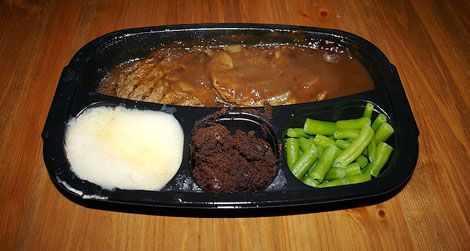I can picture it now: two oblong ground beef patties taking a gravy bath, neatly sequestered in their aluminum compartment to prevent the sauce from bleeding onto the tater tots, pea-and-carrot medley or, most importantly, the apple dessert. A meal for a Hungry Man—or a child of the 1970s with an unsophisticated palate. (I considered TV dinners a treat when I was a kid, especially the ones with built-in dessert.)
The phrase “Salisbury steak” no longer sets off my salivary glands—quite the opposite—but it’s a lot more appetizing than how Dr. James Henry Salisbury described the dish before it was named after him: “muscle pulp of beef.”
And that may be the least nauseating bit in his scatalogically dense 1888 book, The Relation of Alimentation and Disease. Dr. Salisbury, like many people before and since, believed that food was the key to health and that certain foods could cure illness, especially of the intestinal variety. He tested his theories during the Civil War, treating chronic diarrhea among Union soldiers with a diet of chopped-up meat and little else. After 30 years of research he finally published his ideas, setting off one of the earliest American fad diets.
“Healthy alimentation, or feeding upon such foods as the system can well digest and assimilate, is always promotive of good health. Unhealthy alimentation always acts as a cause of disease,” he wrote. Most modern physicians would agree with the sentiment to at least some degree, if not as to what constitutes healthy or unhealthy alimentation (more commonly known as “food” nowadays).
For Salisbury, minced beef patties were health food. The enemies, believe it or not, were fresh fruit and vegetables. When overconsumed “at the expense of more substantial aliments,” he wrote, these led to “summer complaints” in children.
As for the ill soldiers, the problem was an “amylaceous , army biscuit diet,” with not enough variety or nutrients. His prescription:
The first step is to wash out the sour stomach and bowels , and to change the food. The food selected should be such as is least liable to ferment with alcohol and acid yeasts. This is muscle pulp of beef, prepared as heretofore described, when it affords the maximum of nourishment with the minimum of effort to the digestive organs. Nothing else but this food, except an occasional change to broiled mutton.
In the preface, Salisbury described the research that led him to his conclusion:
In 1854 the idea came to me, in one of my solitary hours, to try the effects of living exclusively upon one food at a time. This experiment I began upon myself alone at first…. I opened this line of experiments with baked beans. I had not lived upon this food over three days before light began to break. I became very flatulent and constipated, head dizzy, ears ringing, limbs prickly, and was wholly unfitted for mental work. The microscopic examination of passages showed that the bean food did not digest.
Did the intrepid scientist stop there? Of course not! In 1858 he enlisted six other schlemiels to come live with him and eat nothing but baked beans. He did not mention whether he had a wife who had to put up with seven flatulent, dizzy mopes in her home; my guess is no. Later he and four other guys subsisted solely on oatmeal porridge for 30 days. Other single-food experiments followed, leading him to the conclusion that lean beef, minced to break down any connective tissue and fully cooked, was the best and most easily digested food. By the time the Civil War started, in 1861, he was ready to test his theories on suffering soldiers.
When Salisbury’s book was published, two decades after the end of the war, his ideas caused a sensation. An Englishwoman named Elma Stuart extolled the healing virtues of the Salisbury diet in a book described by one observer as being “written in a popular and racy style,” helping to publicize the mincemeat regimen. For about two decades the diet—not that different, when you think of it, from extreme versions of the low-carb diets of recent years—was all the rage.
Not for another half-century would the Salisbury steak’s future TV dinner companions, tater tots, be invented. By then, Salisbury had been dead for almost 50 years, too late to object to such “unhealthy alimentation.”
–smithsonianmag.com




